
Gymnosperms
Plant Kingdom of Class 11
About Gymnosperms
Gymnosperms (Gk. gymnos; naked; sperma; seed) are naked seeded plants with their ovules freely exposed on open megasporphylls. Goebel has rightly described them phanerogams without ovary.
Gymnosperms are the most ancient seed plants that originated during the late Paleozoic era (265 million years ago), but flourished well during the Mesozoic era. The Jurassic period perhaps the best time for Gymnosperms.
200 million years ago the earth was dominated by the flora of Gymnosperms. Gradually the members of Gymnosperms disappeared and replaced by Angiosperms with changing time and climatic conditions.
Living Gymnosperms are spread over 70 genera and 725 species. Bold (1963) has reported only 722 species of present day Gymnosperms. Of these, some 50 genera and 500 species belong to conifers. About 16 genera and 53 species of living Gymnosperms have been reported from India.
Salient Features
Occurrence
The living Gymnosperms are widely distributed in the cold climates where snow, rather than rain, is the source of water. Cycads occur in tropical and subtropical areas.
A number of Gymnosperms are now grown as ornamentals, e.g., Thuja, Araucaria (native of South America), Ginkgo.
General characteristics of Gymnosperms
- Tap root system is found in gymnosperms which may be diarch or polyarch.
- Some Gymnosperms show symbiotic relationship with algal cells, e.g., coralloid roots of Cycas or with fungus, e.g., mycorrhizal roots of Pinus, Araucaria, etc.
- The main plant body is sporophytic (2n) with well differentiated root, stem and leaves.
- Gymnosperms are perennial, woody with branched stem.
- Two types of leaves i.e. Scaly and foliage leaves are found in them. Foliage leaves are smaller in size and evergreen.
- The leaves of Gymnosperms can be hypostomatic as found in Cycas or amphistomatic as found in Pinus.
- Stem has vascular bundles which are conjoint, collateral and open.
- Secondary growth is present and annul rings appear on mature stem.
- Vessels are generally absent in gymnosperms with exception of order Gnetales (Gnetum, Ephedra).
- Companion cells are absent in phloem of gymnosperms but albuminous cells ( also called as Strasburger cells ) are present which acts like companion cell.
- Leaves have thick cuticle with sunken stomata i.e. it shows xerophytic character.
- Since vascular tissues are present in gymnosperms are also called as tracheophyta and they form embryo hence also called as Embryophyta.
- Reproductive organs are arranged in the form of compact cones. Cones are of two types :male cone (microsporangia) or female cone (megasporangiate), rarely they are bisporangiate.
- Male cones are usually short lived and smaller as compared to female cones.
- The female gametophyte includes archegonia. Each archegonium contains single egg and a ventral canal cell. But neck canal cells are absent in Gnetum and Welwitschia, no archegonia are formed.
- Fertilization (siphonogamy) takes place by the fusion of male and female nuclei resulting in the formation of zygote.
- Pollination occurs by medium of wind i.e. Anemophilous. Pollen tube forms after fertilization process.
- Ovule is of orthotropus type with single integument having three distinct layers : Outer fleshy layer, Middle stony layer, Inner fleshy layer.
- Embryo gets differentiated into radicle, plumule and cotyledons.
- Endosperm gets formed before fertilization and is haploid as it develops from single megaspore.
- Polyembryony occurs in gymnosperm i.e. more than one embryo develops in them.
- Wood can be soft and loose(Manoxylic) as found in Cycas or compact and hard(pycnoxylic) as found in Pinus.
- No closed ovary is found in gymnosperms hence true fruits do not form here.
- Alternation of generation is observed in gymnosperms.
- Sporophytic generation (diploid) is dominant and independent. It greatly exceeds the reduced and dependent gametophytic generation (haploid).
Classification of Gymnosperms

Economic importance of Gymnosperms
Example
Cyas
- Cycas is also known as living fossil as it resembles its characters with extinct cycads.
- Two types of leaves are found in Cycas i.e. green foliage and scaly leaves.
- Young leaves show circinate venation.
- Cycas forms coralloid roots which is a symbiotic association of blue-green algae with root of Cycas.
- Vascular bundle of Cycas is inverted omega in shape.
- Largest ovule amongst plant kingdom is of Cycas.
- Seeds of Cycas are round and orange-red in colour with fleshy covering which attracts the birds.
- Cycas plants lack Female cone. Microspore of Cycas shed at three-celled stage.
- Its seed has a coat called as Testa.
- Stele of Cycas is ectophloic siphonostele.
Pinus
- Pinus is a coniferous gymnosperm having sporophytic plant body with stem, leaves and roots.
- Two types of branches one long and short are found on stem.
- Dwarf branch has foliage leaves which are needle like and are called as spur.
- Two types of cones are produced by Pinus i.e. Male and female cone.
- Male cone is attached on short stalk.
- Pollen dehisce at 4-celled stage .Pollen grain are covered with two wings to make seed dispersal by wind easy.
- No vessels are found in xylem of Pinus.
- Their xylem has tracheid with bordered pits.
- It gives yellow pollen grain which forms a yellow shower also called as shower of sulphur or golden dust.
External Features
The main plant body is sporophyte (2n) and is well differentiated into root, stem and leaves.
Plants possess tap root. In some cases roots show symbiosis with certain algal cells, e.g., coralloid roots of Cycas or with fungus, e.g., mycorrhizal roots of Pinus, Araucaria, etc.
Stems are erect, branched (unbranched in most species of Cycas) and woody. Leaf scars show their characteristic presence on the stem.
Leaves may be of one kind, i.e., monomorphic; or of two kinds, i.e., dimorphic :
Foliage leaves that are all invariably evergreen may be simple or compound, and
Scale leaves that are minute and deciduous
The leaves may be few, large and pinnately compound as in Cycas, numerous small, simple and needle shaped as in Pinus or reduced and scaly as in Ephedra.
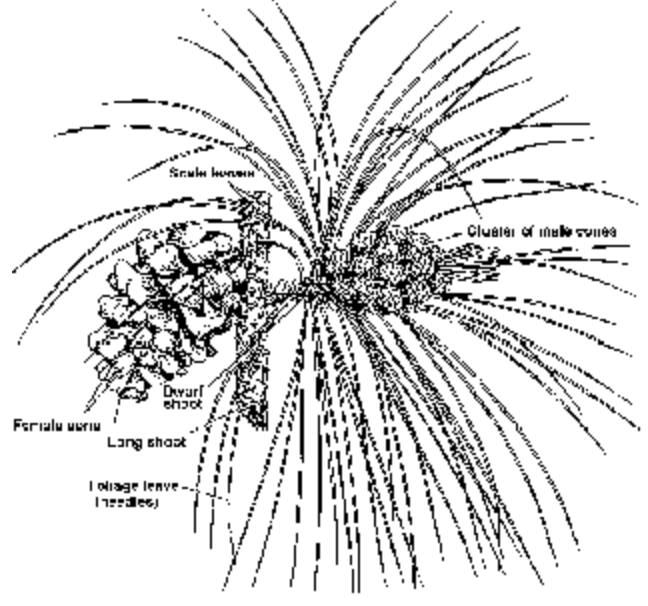
Fig. Pinus: Long and dwarf shoots with male and female cones
Internal Features
Stems are characterized by the presence of collateral and open vascular bundles arranged in a ring, with endarch xylem.
The vessels are absent in the xylem (except in Gnetales) and the companion cells are absent in phloem. However, albuminous cells (Strasburger) are present. Sieve tubes are also not organized as the sieve cells are not placed end to end in rows. Vessels have bordered pits.
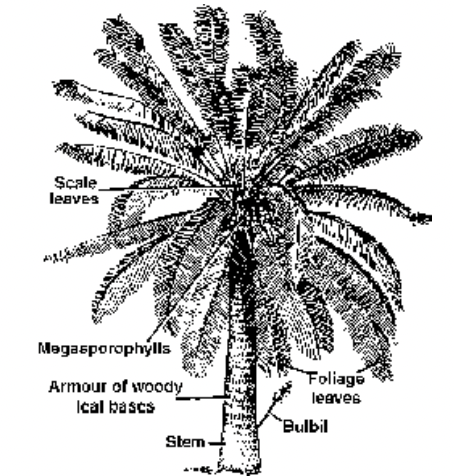
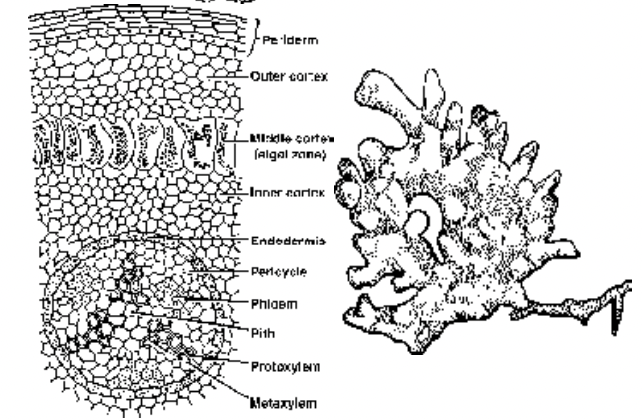
Fig. Cycas: External morphologyFig. Cycas :T.S. of Coralloid root Fig. Cycas : Coralloid roots
Secondary growth is well marked with distinct annual rings. In some Gymnosperms, i.e., Cycas the cambial activity is short lived as a result the pith and the cortex are well developed. Parenchymatous rays are also present. Hence the wood is not compact and is called manoxylic and polyxylic. In others, e.g., Pinus and Taxus, pith and cortex both are much reduced and parenchymatous rays are free. Hence the wood is densely packed and is called as pycnoxylic and monoxylic.
The foliage leaves are protected by thick layers of cuticle and sometimes by an additional waxy layer. Stomata are protected as they develop in the sunken cavities. The leaves of Gymnoperms may be hypostomatic (e.g., Cycas) or amphistomatic (e.g., Pinus). Mesarch xylem and transfusion tissue (hydrostereom) occur in the leaves of most of the Gymnosperms.
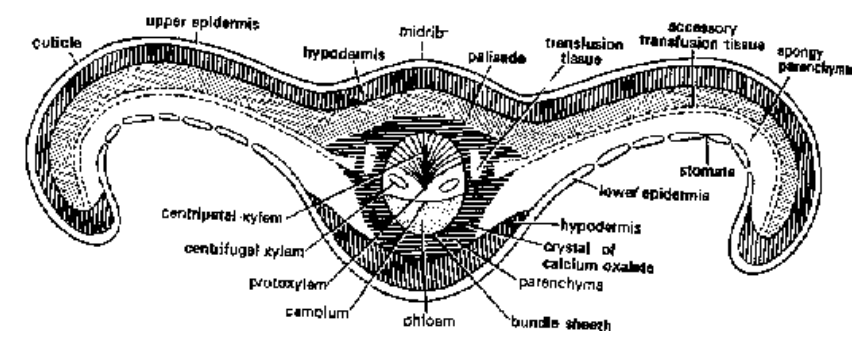
Fig. Cycas : T.S. of leaflet (Diagrammatic)
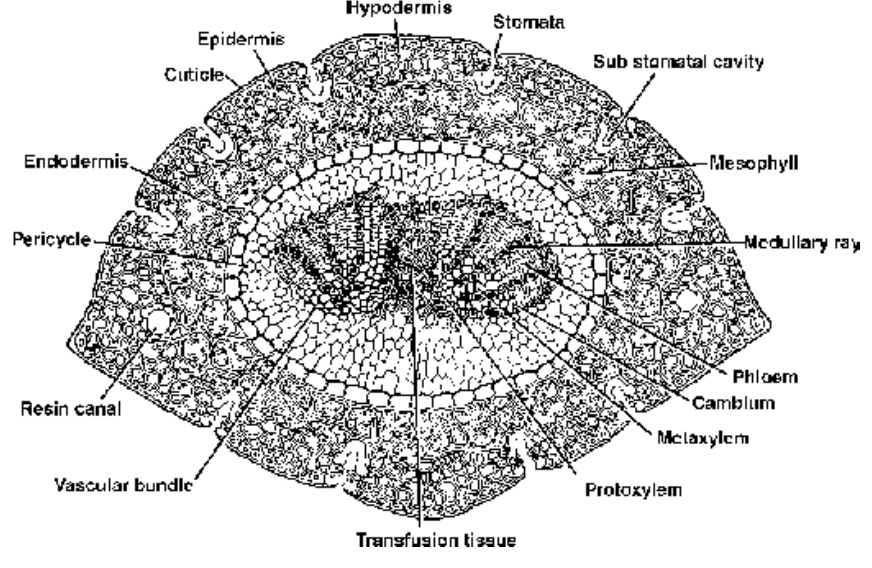
Fig. Pinus : Transverse section of a needle (cellular)
Reproduction
In most of the living Gymnosperms (except ovulate structures of Cycas) reproductive organs are aggregated in the form of compact cones. Cones may either be male (microsporangiate) or female (megasporangiate), rarely they are bisporangiate.
Male cones are usually short lived and smaller than female cones.
Female cones are usually long lived. They sometimes remain on the plants for several years for the maturity and repening of the seeds. Megasporophylls may be foliar and are loosely arranged to form female strobilus (e.g., Cycas) or cauline and compactly aggregated to form female cones (e.g. Pinus).
Microsporangia (pollen sacs) are borne on the abaxial surface of microsporophylls. They may be numerous and grouped in sori as in ferns, (e.g., Cycas) or reduced to two (e.g., Pinus).
Megasporangia (ovules) are borne naked on the sporophyllous scales. They are generally orthotropous and covered by a single integument. Integument that surrounds nucellus may be differentiated into an outer fleshy (outer sarcotesta), inner fleshy (inner sarcotesta) and middle stony (sclerotesta) layers.
The Gametophyte
The plants are heterosporous, i.e., they bear two types of spores
The male gameteophyte bears only one (e.g., Cycas, Gnetum) or two (e.g., Pinus, Ginkgo, Ephedra) prothallial cells.
The female gametophyte possesses archegonia. Each archegonium possesses single egg and a ventral canal cell. Neck canal cells are lacking. In Gnetum and Welwitschia, no archegonia are formed.
Pollination takes place by direct contact of pollen grains with the ovules (anemophilous). Pollen grains are deposited in the pollen chamber where they germinate.
A pollen tube is formed due to elongation of tube cell.
Fertilization (siphonogamy) takes place by the fusion of male and female nuclei resulting in the formation of zygote.
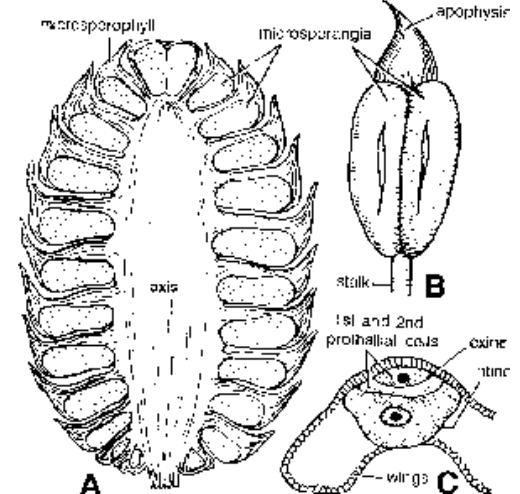
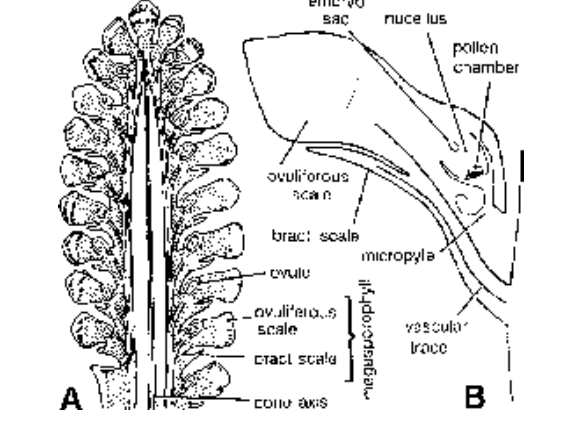
Pinus : Male cone; (A) Longitudinal section of male cone, Fig. Pinus : Female cone; (A) Longitudinal section
(B) Microsporophyll, (C) Microsporeof female cone; (B) A megasporophyll
The Young Sporophyte
The development of the zygote is meroblastic, i.e., only the basal (embryonal) part develops into an embryo while the upper (haustorial) and middle (suspensorial) parts do not participate in the formation of embryo.
Polyembryony, i.e., development of several embyos in one seed out of which though only one survives, is of common occurrence, e.g., Pinus. It is resulted by the formation of several zygotes or cleavage of a single embryonal mass.

Fig. Pinus : Longitudinal section of ovule Fig. Pinus : Stages in development of embryo
Embryo is differentated into radicle, plumule and cotyledons. It is endoscopic, i.e., with the shoot end (plumule) directed away from the micropyle and the root end (radicle) towards the micropyle.
Embyro is developed at the end of long suspensor that is pushed down into the food laden endosperm that develops before fertilization. Female gametophyte, soon after it has absorbed the food from the nucellus, becomes the endosperm. As there does not occur double fertilization or triple fusion, the endosperm is a haploid tissue.
Since there is no closed ovary, true fruits like that of Angiosperms are not found in the Gymnosperm.
Cotyledons may be one or two, e.g., Cycas or a whorl of many, e.g., Pinus.
Seeds may germinate immediately without undergoing a period of rest. Seed coat ruptures, radicle grows downwards and develops primary tap root while the plumule grows upright and develops stem.
Sporophytic generation (diploid) is dominant and independent. It greatly exceeds the reduced and dependent gametophytic generation (haploid).









